
Skat is one of the very few classic card games whose invention can be ascribed
to a particular circle of players at a particular place and time - namely,
around 1810 by members of the Brommesche Tarock Club at
Altenburg, some
twenty-six miles south of Leipzig. And it is surely unique in boasting a
monument dedicated to it. Taking the form of a fountain surmounted by a statue
depicting the four Jacks in conflict, it was erected in 1903, melted down for
its bronze in 1942, but fortunately recast and restored in 1954.
I visited Altenburg in 2013: here's my
album of pictures
(I haven't worked out how to do captions yet, but the main places shown are (in order)
the station, the playing-card museum, the Skat fountain, a mustard shop (yes, really!),
the pubby branch office of the Deutcher Skatverband, and general street views.)
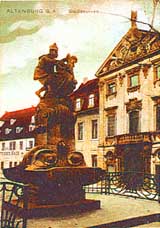
Altenburg Skat Fountain
The leading light of the story was an advocate by the name of Friedrich Ferdinand Hempel. Hempel's coachman had been travelling in the Erzgebirge and there picked up a local variant of the more southerly game of Schafkopf, which he brought to his employer's attention knowing him to be a card-playing enthusiast. It was a version of the game with all Unters (Jacks) as top trumps but without Obers (Queens) as second tops (unlike most varieties of Schafkopf), and with Ten ranking low between Ober and Nine. It was either played by three or converted to three-handed play by Hempel's circle, who were more accustomed to three-handed Tarock. The principal stages of development were outlined by Hempel in an 1818 issue of the Osterländische Blätter, and in further detail by Professor J. F. L. Hempel in 1833 and 1848.
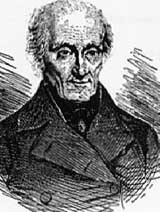
J F L Hempel
At first, the dealer received 12 cards to the others' 10 each, made two discards (skat = "discard"), and sought to take 61+ card-points in a trump suit previously cut from the pack. This risky business was soon changed by dealing the last two cards to the table and allowing each player an opportunity to become the soloist by picking up the skat. In another version, bells (diamonds) were made permanent trumps, as in many forms of Schafkopf. In another, bells could be overcalled by hearts, which won or lost double, hearts by leaves (quadruple), and leaves by acorns (octuple).
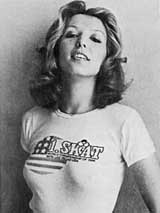
Not J F L Hempel
By 1820 a major innovation, credited to Carl Adam Neefe, permitted a simple skat-exchange bid (Frage) to be overcalled by a "solo" or "hand" game. Game values were now 1-2-3-4 for Frage in bells, hearts, leaves, and acorns respectively, and 5-6-7-8 for the same played solo. There was no grand or null, and bids were made by suit, not by value.
At the time of the 1833 description Skat was spreading throughout Thuringia, having by 1826 reached Leipzig University and thus entered the circulation of the nineteenth-century equivalent of wandering scholars. Tens now ranked high, and in some unorthodox circles extra payments were being made for the holding of "matadors", or consecutive top trumps, a feature borrowed from Hombre. At first, such payments were end-of-play extras and had no effect on the bidding, which was still carried out by suit - that is, a bid in a higher suit beat an equivalent bid in a lower suit regardless of the number of matadors involved. Some players, however, especially students, replaced simple suit-bidding with that of raising according to the value of the game they expected to win with the eventual score for matadors included. This meant that a bid in a given suit could now be overcalled by an equivalent bid in a lower suit played with or without a greater number of matadors. The traditionalists referred disparagingly to this practice as Räuber-Skat ("Robber Skat"), because a player with a promising game in a high-valued suit could be "robbed" of his due by an upstart low suit more strongly supported by matadors. The struggle between suit valuation and game valuation would remain a contentious feature of the game for many years to come.
By 1848, a number of variations were being introduced from other games such as Hombre, Tarock, and Boston, probably independently in a variety of places. These included grand and null, both originally playable only from the hand, and both castigated as unnatural by the purists. Both also had variants. Däuserspiel was a grand in which Unters (Jacks) were not trumps but ranked in each suit between Ober (Queen) and Nine, thus making Däuser (Deuces, the equivalent of Aces) invincible. Nullogrand was a null played in grand format, i.e. with Unters (Jacks) as trumps.
By 1867 some circles had borrowed from Hombre the bid of tourné (German Wende), whereby the highest bidder undertook to turn the top card of the skat and accept its suit as trump. At a later date he could play "second turn" if the first did not suit him ("Paßt mir nicht"). Several varieties of Ramsch are recorded by Hertefeld in his classic work of 1884, as well as such aberrations as Uno and Duo - both played as at grand, but with the object of taking exactly one or two tricks respectively. Other peculiarities included the announcement "mit Spitze", whereby the soloist undertakes to win the last trick with the lowest trump, and the decidedly eccentric bid of Spitzengrand, in which cards retain their point-values but rank upside down in each suit, from Seven high to Ace low.
The indigenous Skat-players of Thuringia objected to such fripperies for the difficulty of deciding and remembering whereabouts they all fitted into the bidding schedule - a problem less acute in Leipzig, Berlin, and the north, where players preferred to bid by game value rather than suit value. If no form of Skat could yet be rightly designated standard, that described by Hertefeld in 1884 is at least typical of its time. The base values for diamonds, hearts, spades, and clubs, respectively, were, in Frage 1-2-3-4, tourné 5-6-7-8, and solo 9-10-11-12. Grands counted tourné 12, solo 16, ouvert 24; and nulls had fixed values tourné 16, solo 24, both doubled if played ouvert, and "revolution" 72. The last-named was a null ouvert so invincible that the opponents were invited to show their hands, discuss the position, and exchange as many cards as they liked before playing. Like most experts, Hertefeld countenanced neither null nor grand played with simple skat exchange, though both were practised - the former under the name Kauf- or "Purchase-" null, the latter as Gucki or "Peep" grand.
Stronger and more widespread objections stemmed from the fact that two players from different circles, let alone different parts of the country, could hardly sit down for a bout of "Skat-threshing" (Skat dreschen) without first going through a lengthy check-list of mutually acceptable games, values, bidding procedures, and pay-offs, with the risk of total dissatisfaction with the resultant compromise.
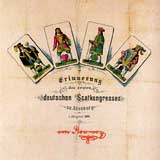
Table napkin souvenir
of 1886 Congress
Thus arose, in the wake of German unification and the founding of the First Reich in 1871, an equally patriotic move towards the unification of the new state's national game, culminating in the first National Skat Congress at Altenburg in 1886 and the promulgation - if not exactly the widespread acceptance - of the first Allgemeine Deutsche Skatordnung (General Rules of German Skat). A second soon followed at Leipzig, and the third, at Halle-Saale in 1899, saw the founding of the Deutscher Skatverband. In 20th-century post-war Germany its West German descendant moved to Bielefeld, but with German reunification it has reverted to Altenburg.
Whether these early congresses actually achieved unity is questionable. Delegates and officials made such a claim, but perhaps only amongst themselves, and because it made them feel their efforts had been worth while. How attuned they were to general practice may be gauged from the official insistence on playing with German-suited cards, when sales of French-suited Skat cards were three times as great, and on the Altenburg practice of bidding by suits when most of the population followed the Leipziger practice of bidding by game valuation. Ramsch was not admitted as part of the official game, a ruling that "officially" applies today, even though nearly everyone still plays it, except in tournaments. Subsequent congresses continued to endorse the original Skatordnung until the 1920s, by which time it had fallen even further out of step with everyday practice.
During the First World War, Skat underwent considerable levelling at the hands of soldiers constantly on the move and mingling with their regional compatriots. The distinguishing features of what was now called Leipziger Skat were (a) bidding by game valuation and (b) the admission of a grand played with skat-exchange, whence the alternative name Gucki-Skat. The eleventh Congress (Altenburg, 1927) agreed to adopt for a one-year experimental period the Leipziger Skatordnung first published in 1923, and its ratification in 1928 established the main lines of the modern German game. Tourné was abolished, as were differing suit-game values in favour of the universal 9-10-11-12 with an extra multiplier for hand-play. Grand and grand ouvert were respectively valued 20-30, and the fixed nulls 23-25-46-50. In 1932 these were revised to 24-36 and 23-35-46-59, and in 1937 the system was completed by the admission of suit games playable "ouvert, with Schwarz declared".
It would be idle to pretend that everyone follows the official Skatordnung
in domestic and informal play, especially in northern Germany, Berlin being a
particular hotbed of heresy. Writing in 1969, the Berliner politician Ernst
Lemmer offered the following check-list of points to be agreed when members of
different Skat circles get together. "Uncertainties may still exist", he says,
as to whether:
? Grand counts 20 or 24
? Doubling and redoubling are permitted
? If so, whether nulls may be doubled
? Null hand is an acceptable bid
? Null ouvert hand counts 59 or 69
? Revolution may be bid
? Hand games count double if lost
? Ramsch or Schieberamsch shall be played
? Bock rounds are played, and, if so, when
? Mit Spitze(n) may be bid, and, if so, when
? Stakes are played for, and, if so, how high.
Revolution, by the way, scores 92. "Bock", a round of deals on which all scores are doubled, even if doubled or redoubled already, is often imposed after a specified event, such as a lost grand, or any game lost 60-60 ("Arsch-gespalten"). (Many players concur with Lemmer in regretting that grand was raised from 20 to 24. Grands are about two-thirds as frequent as suit games, but are worth more than twice as much, and are considerably less interesting to play. If the purpose is to ensure that the lowest grand (formerly 40) cannot be overcalled by null ouvert (46), it would seem preferable to abolish nulls played with skat-exchange.)
German reunification in 1989 resulted in more contact between Skat-players in opposite and previously opposed parts of the country. The latest revisions, made at the 1999 Congress, reconciled previous differences between the Skatordnung of the Deutscher SkatVerband and that of the ISPA (International Skat-Players Association) based in Berlin. The most substantial of these are (from most to least sensible):
- Grand ouvert, previously having a base value 36 instead of an extra multiplier for the ouvert, reverts to its natural base value of 24 with the extra multiplier. This reduces the maximum possible contract score from 360 (10 × 36) to 264 (11 × 24);
- Failed contracts played from the hand are now lost double, instead of single as was the case before.
(I have a sneaking suspicion that the second of these was reluctantly accepted by the DSkV in exchange for the ISPA's agreeing to devalue their null ouvert hand bid from 69 to 59, but can't help regretting that the DSkV failed to acknowledge the ISPA's more sensible valuation of Grand at 20 instead of 24.)
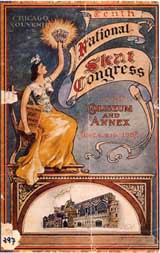
Souvenir program of 10th
National Skat Congress,
Chicago 1904
Skat was taken to America by German immigrants and a series of Skat congresses
along similar lines to those of its home country began at Brooklyn in 1887.
An American Skat League was founded in 1898 at the fourth of the series, which
continued in 1926. American Skat could be described as a streamlined version of
the German game prior to the substantial revisions it underwent in 1927-8.
Whereas German Skat kept the simple Frage or skat-exchange bid and
shed that of tourné, American Skat instead abandoned that of
skat-exchange in suit (though not at grand). The base values of North American
Skat are tournée 5-6-7-8 and solo 9-10-11-12, making the lowest
possible bid 10 (diamond tourné with or without one). Grands are valued
at 12 for tourné (optional if a Jack is turned, the other choice being
to play in the suit it belongs to), 16 guckser (with the skat), 20 solo (hand),
24 ouvert. Null and null ouvert, playable only from the hand, count 20-40
respectively.
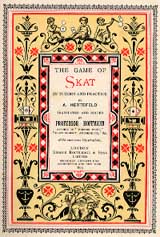
Hoffmann, title page
Players acquainted only with the German game may find the
American one more stimulating. Properly approached, tourné is not as
chancy as it sounds. It sometimes forces you into playing with only four
trumps, which, though something of a challenge, is by no means unwinnable, and
is very rewarding to win. Grands have more sensible values, and the rejection
of nulls with the skat has much to commend it. Ramsch, played when no one is
prepared to bid, is an integral part of the official rules. Or perhaps we
should say "was", as it now seems to have gone into steep decline.
Right: Hertefeld, A, Illustriertes Skat-Buch (Breslau 1884). Its English translation by "Professor Hoffmann" (Angelo Lewis), appeared in 1893, but failed to take Britain by storm. Bridge, a newcomer, was much easier to learn.
Skat is (or was?) also played in Texas. The Texas Skat League, established 1924, favours a form of the game still called Robber Skat. It shares the streamlined values of its North American cousin, but, as in Germany, retains the simple exchange game in place of tourné. The recent disappearance of its web site suggests that it, too, may be on the way out.